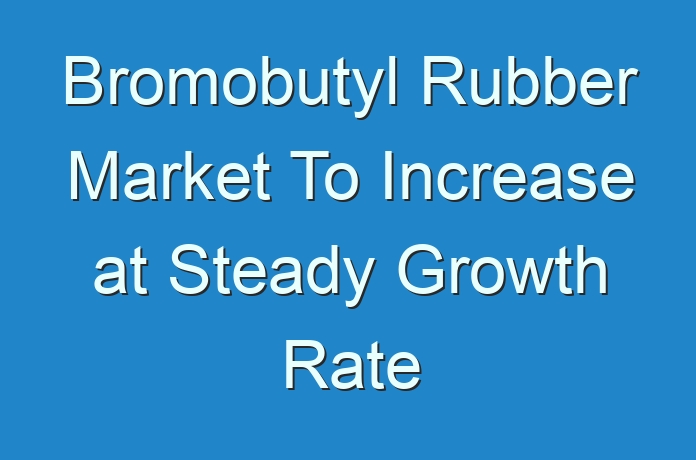
Bromobutyl Rubber Introduction
- Bromobutyl rubber is produced by reacting bromine with a hexane solution of butyl rubber in a two-step process. In the first step, polymerization of isobutylene and isoprene takes place to produce butyl rubber (IIR). The second step involves bromination to form bromobutyl rubber. The mechanism of polymerization consists of complex cationic reactions.
- Bromobutyl rubber exhibits many of the attributes of butyl molecule. These include physical strength, vibration damping, low glass transition temperature, low permeability, and resistance to aging and weathering from atmospheric exposure. These attributes make bromobutyl rubber an ideal material in tire liner applications.
- In terms of application, the global bromobutyl rubber market can be segmented into tires & tubes, adhesives, sealants, gloves, and others. The tires & tubes segment is expected to expand at a significant pace during the forecast period owing to increase in usage of bromobutyl rubber in the tread of tires. Bromobutyl rubber helps enhances tire grip and the associated wet braking performance without compromising rolling resistance. Bromobutyl rubber is also extensively employed in pharmaceutical closures.
Request Brochure:
https://www.transparencymarketresearch.com/sample/sample.php?flag=B&rep_id=79423
Key Drivers of Bromobutyl Rubber Market
- Superior and advanced properties of bromobutyl rubber vis-à-vis chlorobutyl and regular butyl rubber in terms of physical strength, vibration dumping, aging, heat resistance, low glass transition temperature, and low permeability are expected to augment the bromobutyl market during the forecast period
- Rise in production and sale of passenger vehicles is likely to boost the consumption of bromobutyl rubber in the near future. Increase in disposable income and increase in purchasing power parity have augmented the production and sale of passenger vehicles across the globe. Bromobutyl rubber is primarily used in inner liners of tires of these passenger vehicles to keep tire pressures constant over a long period. This is anticipated to drive the demand for bromobutyl rubber during the forecast period.
- Bromobutyl rubber has the ability to cure rapidly using vulcanization systems by yielding very low extractable residues. Thus, it is an elastomer of choice for pharmaceutical and health care applications. The moisture resistance of bromobutyl rubber is an added advantage. This is projected to boost the demand for bromobutyl rubber in pharmaceutical and health care end-user segments.
- High volatility in prices of natural rubber (NR) and lengthy process associated with its cultivation is also boosting the consumption of bromobutyl rubber
Enquiry Before Buying:
https://www.transparencymarketresearch.com/sample/sample.php?flag=EB&rep_id=79423
Key Restraints of Bromobutyl Rubber Market
- Fluctuation in raw material prices can hamper the global bromobutyl rubber market in the next few years. Bromobutyl rubber (IIR) is prepared by reacting bromine with a hexane solution of butyl rubber in a two-step process. Hexane solutions and bromines are experiencing very unstable prices, as the supply chain has been disrupted due to the COVID-19 pandemic. These raw materials experience periodic fluctuation in demand and thus their prices are significantly affected. This is restraining the global bromobutyl market.
- Environmental concerns and lack of universal enforcement directives pertaining to applications of bromobutyl rubber are also estimated to restrain the market. Bromobutyl rubber manufacturing facilities create air and noise pollution. Therefore, governments of various countries across the globe have brought into effect regulations to ensure that safety standards are adhered to during the production of bromobutyl rubber. These regulations are projected to hamper the market in the near future.
Buy Now:
https://www.transparencymarketresearch.com/checkout.php?rep_id=79423<ype=S
Impact of COVID-19 on Bromobutyl Rubber Market
- The COVID-19 pandemic is causing widespread concerns and economic hardships for key players operating in the global bromobutyl rubber market. The industry has been adversely affected by the COVID-19 outbreak on numerous fronts. These include low demand and productivity, operational and supply chain disruptions, tightening credit markets, and lack of adequate workforce.
- The bromobutyl rubber market’s supply chain has historically been strongly dependent on China, which has been heavily impacted by the COVID-19 pandemic. In order to tackle this outbreak, major players have instituted a wide range of countermeasures such as assessing links in supply chain and identifying potentially weak ones, real-time situational awareness, immediate implementation of sanitation measures, and reconfiguration of workspaces for safety.
Asia Pacific to Hold Major Share of Global Bromobutyl Rubber Market
- In terms of region, the global bromobutyl rubber market can be split into North America, Europe, Asia Pacific, Latin America, and Middle East & Africa
- Asia Pacific is projected to hold significant share of the global market in terms of consumption during the forecast period. Growth in automotive production and sales of passenger vehicles in China, South Korea, Japan, and India is expected to augment the consumption of bromobutyl rubber in automotive tires and tubers. Rapid growth in the building & construction industry is also augmenting the demand for bromobutyl rubber in adhesive and sealants applications. Bromobutyl rubber has various properties such as air impermeability, weather resistance, heat resistance, and aging resistance. These properties are driving the demand for bromobutyl rubber in the construction industry.
- The joint venture company of Reliance and Sibur is likely to be the first manufacturer of bromobutyl rubber in India. This manufacturing facility is expected to lower the country’s dependence on import. Demand for bromobutyl rubber is increasing significantly in Malaysia, Indonesia, Vietnam, the Republic of Korea, Hong Kong, Macau, and Australia.
- North America is projected to account for large share of the global bromobutyl rubber market during the forecast period owing to presence of major automotive players and rise in renovation of buildings in the U.S. and Canada
- Growth in the building & construction industry and rise in industrialization in countries in Middle East & Africa such as Saudi Arabia, the UAE, and South Africa are expected to augment the demand for bromobutyl rubber in various applications in these countries





